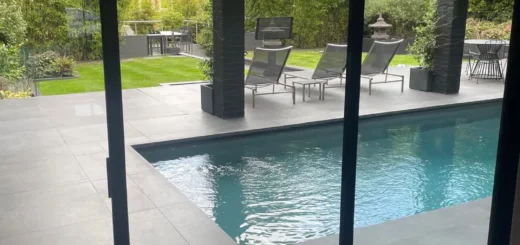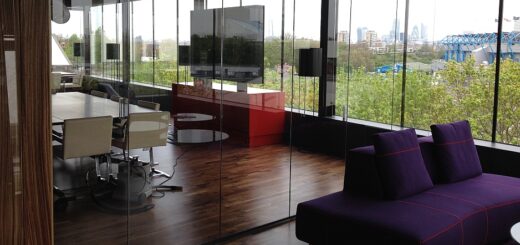Double Glazed Aluminium Doors: Technical Guide & Features
Table of Contents
Modern Double Glazed Aluminium Doors Explained
Double glazed aluminium doors blend advanced engineering with practical benefits for British homes. These systems have evolved hugely since their introduction in the 1970s, with modern frames now incorporating thermal break technology and high-performance glass units.
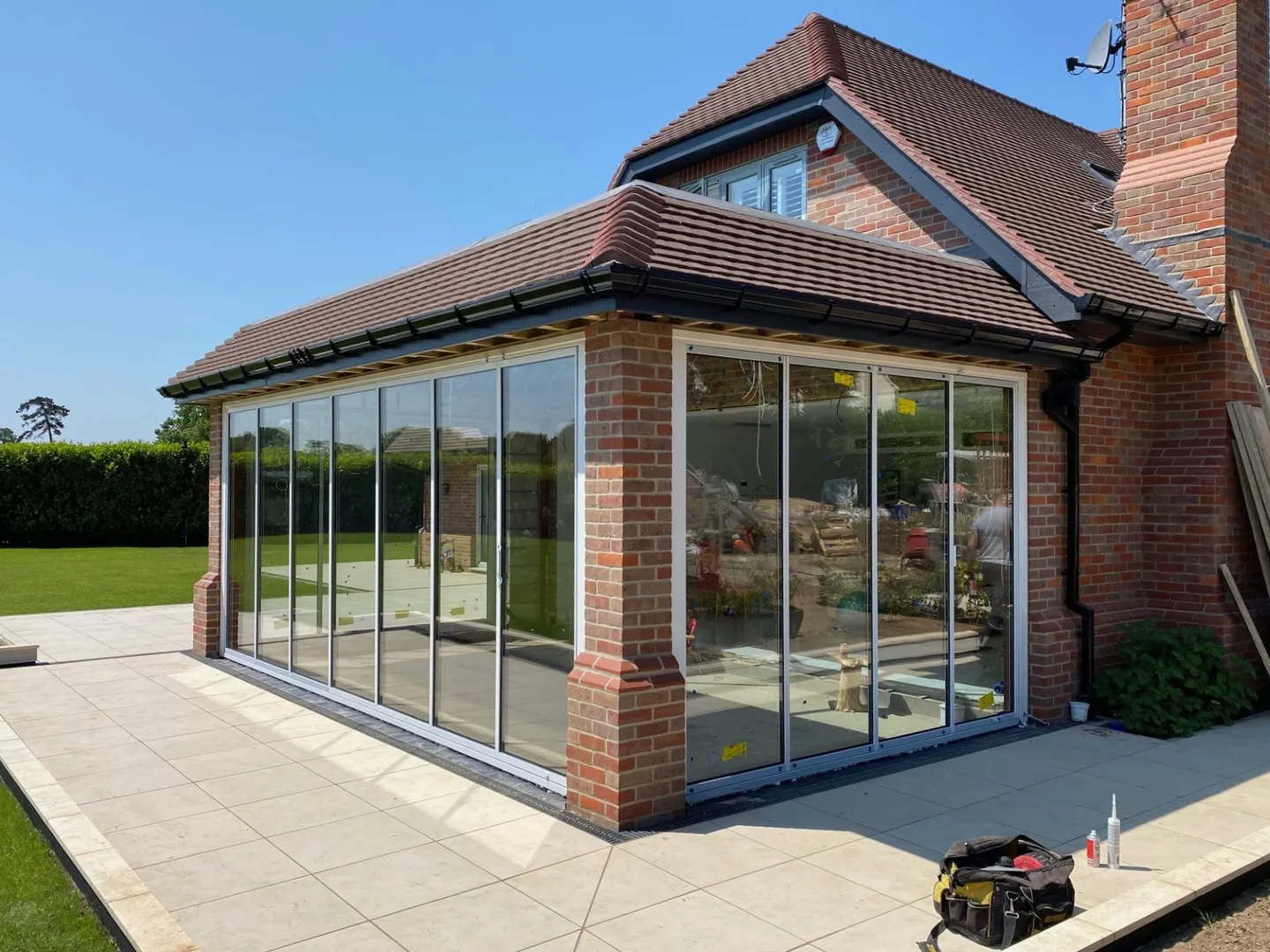
A Brief History of Aluminium Door Design
The earliest aluminium frames suffered from poor insulation and condensation issues. Cold bridging – where metal conducts heat directly from inside to outside – made these early double glazed aluminium doors impractical for British weather.
By the mid-1980s, manufacturers developed polyamide thermal breaks, inserting a non-conductive barrier between the inner and outer frame sections. This breakthrough greatly cut heat transfer through modern aluminium frames.
Glass technology has progressed alongside frame design. Modern double glazed aluminium glass doors now incorporate gas-filled cavities and microscopic metal oxide coatings. These technical improvements have made aluminium an excellent choice for energy efficient doors, particularly in exposed locations where weather resistance matters most.
Breaking Down Double Glazing Technology
Modern patio doors generally use at least two panes of glass separated by a spacer bar, typically filled with argon gas. This construction method creates an insulating barrier that blocks heat loss while letting natural light flood through. The spacer bar contains moisture-absorbing materials to prevent condensation between the panes, while special coatings on the glass surface reflect heat back into your home.
The glass unit works with the frame’s thermal break to create a complete insulation system. Aluminium’s inherent strength allows for slimmer frames than other materials, which means larger glass areas without compromising structural integrity. This combination of durability and thermal performance has made sustainable home design more achievable in the British climate.
Why Aluminium Frames Stand Out
Strength-to-Weight Benefits
The molecular structure of aluminium gives it remarkable strength despite its low weight. This means double glazed aluminium doors can support bigger glass panels while maintaining slim sight lines – the visible frame width when looking through the door. The material’s structural properties allow for taller and wider openings than traditional frame materials, without the bulk associated with timber or uPVC.
Types of Double Glazed Aluminium Doors
Modern homeowners have several distinct options when choosing double glazed aluminium doors. Each design offers specific advantages based on the layout of your space and how you plan to use the doors.
Sliding Door Systems
Double glazed aluminium sliding doors operate on precision-engineered tracks, letting large glass panels glide past one another. The mechanics behind these systems rely on steel rollers housed within the frame’s bottom rail. Higher-quality contemporary sliding doors may incorporate multiple rollers per panel, spreading the weight evenly across the track. This engineering choice improves long-term reliability and makes the panels easier to move.
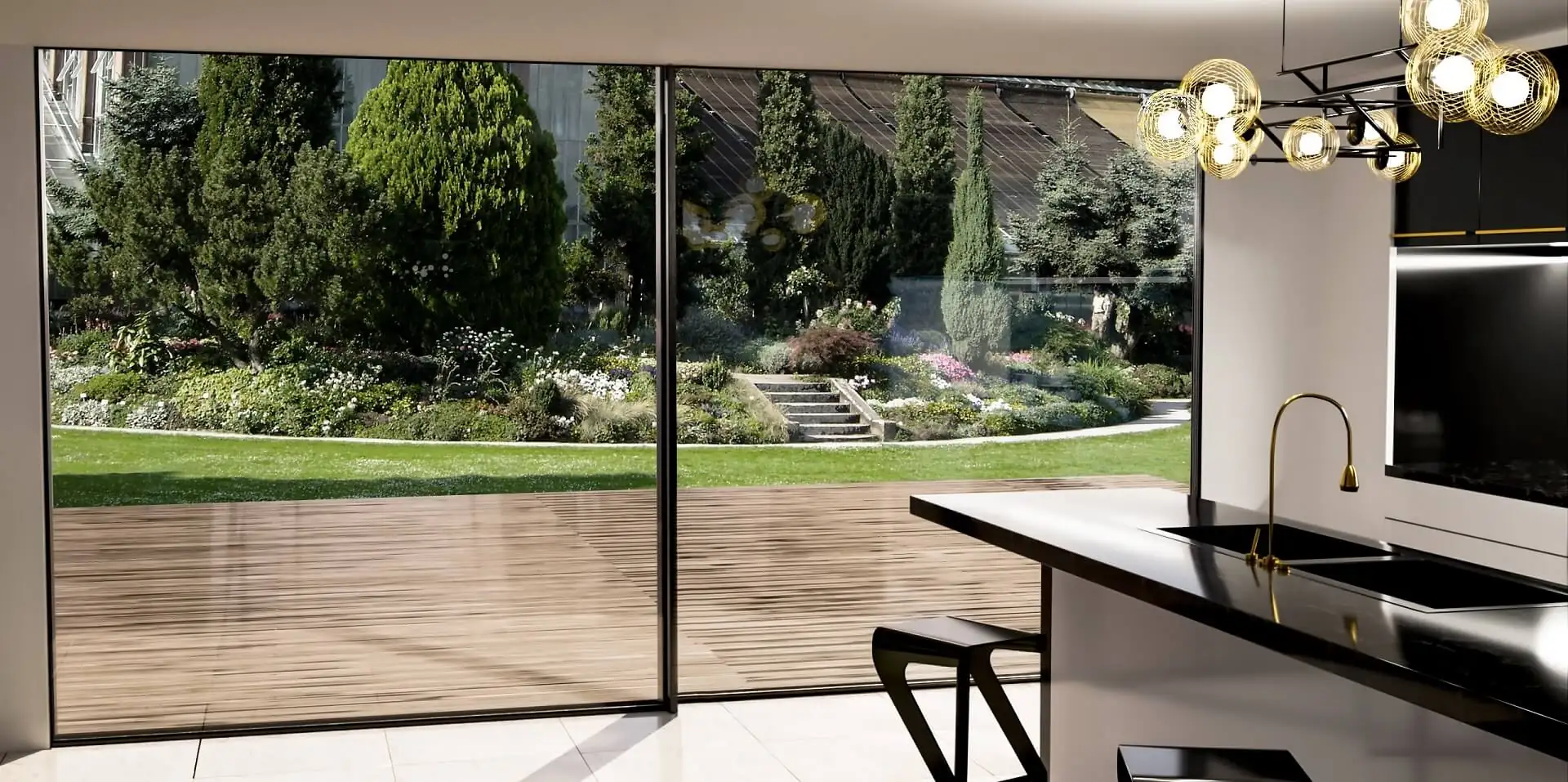
When specifying sliding systems, panel weight becomes a primary factor. Larger glass units in double glazed aluminium doors need robust roller assemblies – typically either stainless steel or sealed bearing designs. These components determine how smoothly the door will operate over its lifespan.
Technical Specifications
Track systems come in various configurations, from basic two-panel designs to multi-track setups where three or more panels stack behind one another. The frame depth varies based on the number of tracks, while the glass specification changes depending on the panel size and location. Exposed coastal properties often need toughened glass with special coatings to resist salt spray and wind loads.
Bifolding Door Designs
Double glazed bifold doors fold and stack against themselves, creating wide, unobstructed openings. The engineering involves precision hinges and roller sets working together as the panels fold. Each panel connects to the next via specialist hinges, while the weight transfers through the top and bottom of the frame.
Running gear quality makes a substantial difference in day-to-day operation. Cheaper systems often use simple wheel assemblies, while premium designs incorporate bearings and adjustable rollers. This difference becomes apparent over time – better components maintain smooth operation even after thousands of cycles.
The configuration options for external doors in bifold designs vary widely. Three-panel systems suit smaller openings, while larger spaces might use six or more panels. Traffic doors – panels that open independently like a normal door – add convenience for everyday use without operating the entire system.
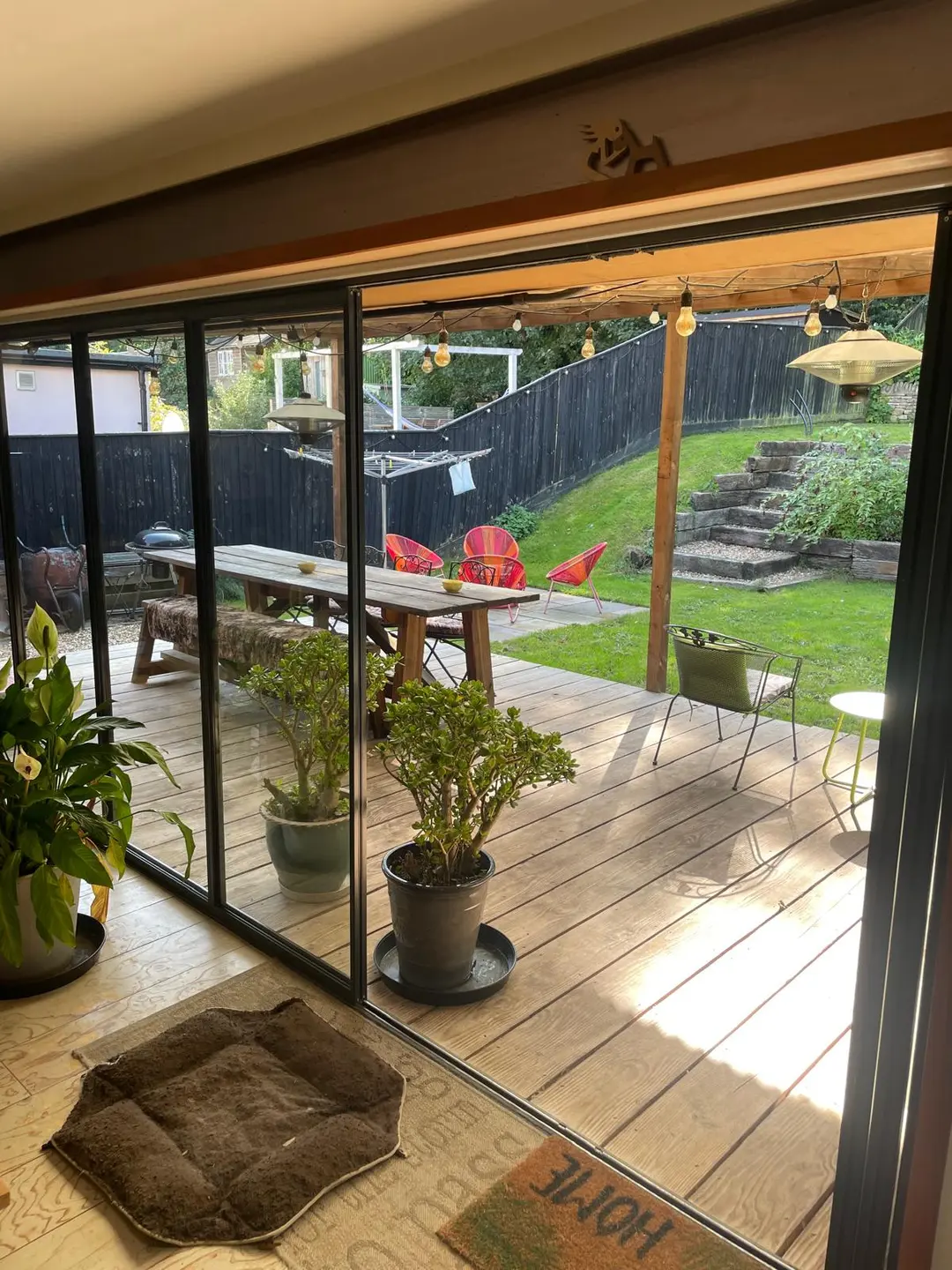
Slide and Fold Mechanisms
These systems combine sliding and folding actions, offering improved flexibility over standard designs. Unlike traditional double glazed aluminium doors, slide and fold systems let panels move along the track before pivoting to stack. This design saves space compared to regular bifolds while providing similar opening widths.
The mechanism uses specialized hardware at each panel’s pivot point. When opening, the panels slide until reaching preset positions, then rotate on vertical pins. Engineers have refined this process to need minimal force, despite the complex movements involved.
The bottom track design proves essential in these systems. Some manufacturers use a low-threshold option that sits almost flush with the floor, while others opt for a more substantial track that offers improved stability. Your choice depends on factors like exposure to weather and whether you need level access.
Frameless Glass Options
Advanced manufacturing now allows for minimal frame designs in double glazed aluminium glass doors. These systems use structural glazing techniques where the glass itself provides stability. Special clamps and fixings secure the panels while remaining almost invisible.
The glass specification becomes even more important in frameless designs. Toughened or laminated safety glass, precisely calculated for the opening size, ensures the system remains secure. The edges require careful processing to prevent stress points that could lead to breakage.
Temperature changes can cause the glass to expand and contract. Modern frameless systems account for this movement with flexible gaskets and precise gap calculations. This attention to detail prevents binding or sticking as weather conditions change throughout the year.
Performance Features of Double Glazed Aluminium Systems
Double glazed aluminium doors excel in several performance areas that matter to British homeowners. The combination of modern glass technology and thermally broken frames delivers excellent results in real-world conditions.
Thermal Efficiency Explained
Double glazed aluminium doors incorporate thermal break technology – a non-conductive barrier between the inner and outer frame sections. This design stops heat escaping through the metal frame, while low-emissivity glass coatings bounce warmth back into your rooms. The result? Lower heating bills and warmer spaces near the doors during winter months.
Thermal insulation in these systems comes from multiple components working together. The gas-filled cavity between glass panes creates a buffer zone, while the thermal break prevents cold spots around the frame edges. Modern double glazed aluminium glass doors can achieve impressive energy performance ratings, matching or surpassing traditional materials like timber.
Technical Performance
The glass specification plays a vital part in insulated doors. Low-emissivity coatings – microscopically thin metal oxide layers – reflect heat while allowing natural light through. Different coating combinations suit various climates and orientations, with some optimised for solar control in south-facing installations.
Sound Insulation Properties
Garden sliding doors, for example, need effective sound insulation to maintain peace inside your home. Double glazed aluminium doors reduce noise through several mechanisms: the air gap between glass panes dampens sound waves, while rubber gaskets around the frame absorb vibrations. Different glass thicknesses in the same unit can block specific sound frequencies more effectively.
The frame design influences acoustic performance too. Modern double glazed aluminium doors use multiple rubber seals and brush strips to close any gaps where sound might leak through. Larger air gaps between the glass panes generally improve sound reduction, though this needs balancing against other performance requirements.
Weather Protection
British weather demands robust protection from wind and rain. Double glazed aluminium doors use multi-point locking systems that pull the frame tight against its seals. Water management channels built into the frame direct rainfall away from vulnerable areas, while pressure equalisation slots prevent wind-driven rain from forcing its way inside.
The thermal break in these systems also helps prevent condensation control issues. By keeping the inner frame surface closer to room temperature, moisture in the air is less likely to condense on the metal. This reduces the risk of mould growth and extends the life of surrounding decorative finishes.
Testing proves how well these systems work in challenging conditions. Double glazed aluminium doors undergo rigorous water penetration and air permeability tests before receiving certification. The results show how effectively modern systems resist driving rain while maintaining comfortable indoor temperatures.
Temperature Management
Different glass coatings suit different situations. South-facing double glazed aluminium doors might need solar control glass to prevent overheating in summer, while north-facing installations focus on keeping heat inside during winter. The spacing between glass panes also influences thermal performance – wider gaps generally mean better insulation, up to a point.
The frame’s thermal break thickness varies between manufacturers and price points. Premium systems use wider thermal breaks with more advanced materials, achieving better insulation values. This difference becomes noticeable in energy performance calculations and real-world comfort levels near the doors.
Practical Buying Tips
Selecting double glazed aluminium doors requires careful thought about how you’ll use the space. The right configuration depends on your property’s layout, local weather patterns, and daily routines.
Size and Configuration Options
Double glazed aluminium doors come in various panel arrangements to suit different openings. Wide patio doors might use a simple two-panel sliding design, while larger spaces could need more complex setups. A typical 4 panel sliding doors arrangement provides excellent access while keeping the frame profiles slim – ideal for modern homes where views matter most.
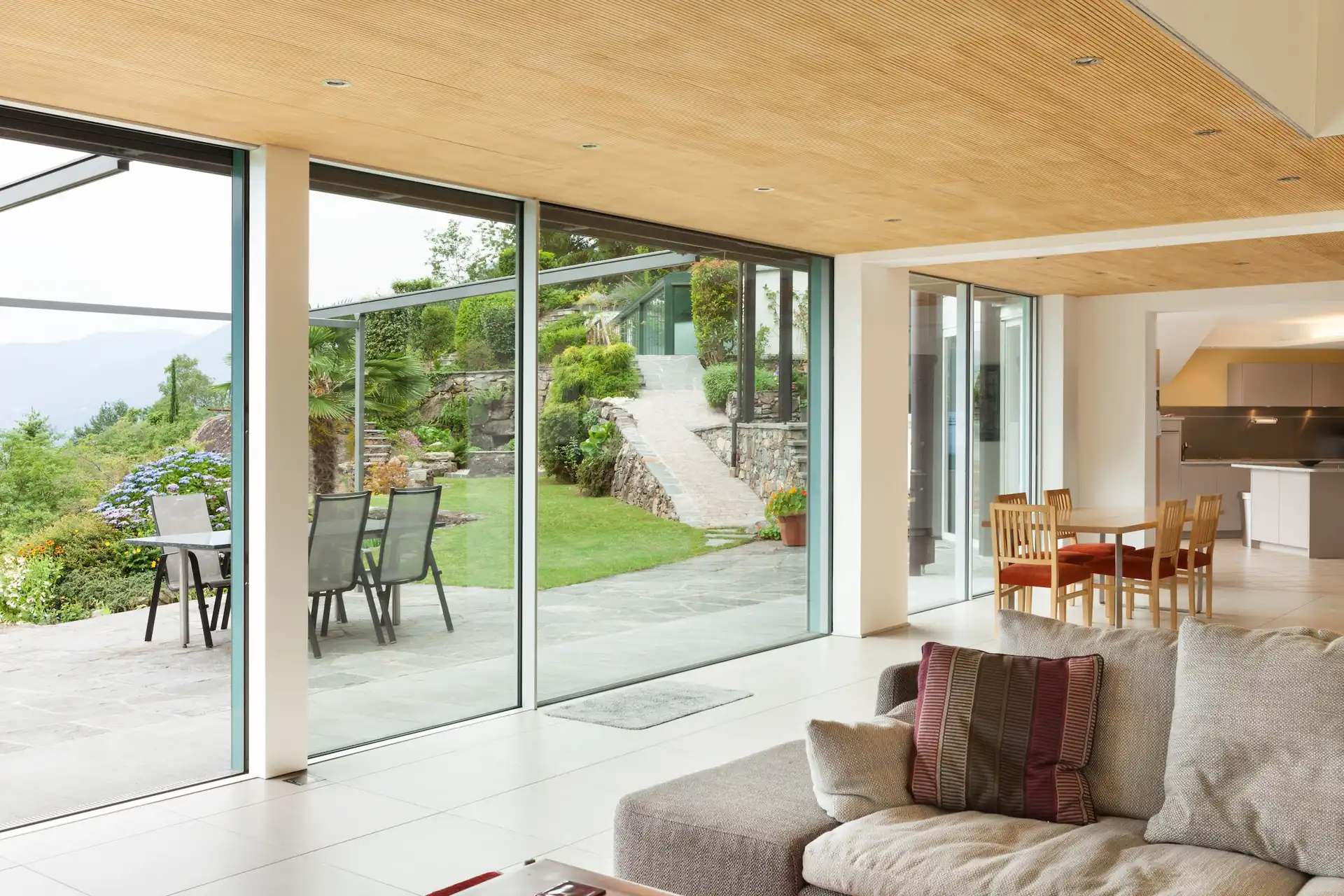
The size limits for double glazed aluminium glass doors vary by manufacturer and system type. Each panel’s height-to-width ratio must stay within engineering tolerances to prevent warping or operational issues. Glass weight becomes a limiting factor too, especially in sliding systems where each panel needs proper support from its rolling gear.
Opening Configurations
Common panel arrangements include:
- Single sliding door with fixed panel
- Two-panel sliding system
- Three-panel design with two sliding sections
- Corner sets that open at right angles
- Slim-meeting stiles for larger clear openings
Frame Finishes
Double glazed aluminium doors offer numerous finish choices beyond standard white or grey. Powder coating – a process where dry paint particles bond to the metal surface – creates durable, fade-resistant colours. Textured finishes hide minor scratches better than smooth ones, while metallic coatings add depth to the surface appearance.
The coating process needs careful quality control. Premium systems use pre-treatment processes that improve paint adhesion and prevent corrosion under the coating. This preparation step proves particularly important in coastal areas where salt spray can damage poorly finished surfaces.
Glass Specifications
Glass options for these systems go beyond basic double glazing. Laminated inner panes improve security and reduce UV damage to furnishings. Solar control coatings cut summer heat gain without making rooms too dark, while acoustic glass combinations reduce traffic noise through multiple layer thicknesses.
The glass edge seal quality makes a long-term difference. Premium units use warm-edge spacer bars that conduct less heat than traditional aluminium spacers. These components reduce the risk of seal failure while improving overall thermal performance around the glass edge.
Hardware Choices
Handle designs range from basic drag pulls to sophisticated multi-point locking systems. Premium hardware uses marine-grade stainless steel to resist corrosion, while standard options might need more frequent cleaning to maintain their appearance.
Security features deserve special attention. Modern double glazed aluminium doors include anti-lift blocks, multi-point locks, and sometimes electronic monitoring systems. The locking points should engage smoothly without needing excessive force – a sign of good frame alignment and quality manufacturing.
The door’s operation depends heavily on its rolling gear quality. Better systems use sealed bearing wheels rather than simple plastic rollers. This difference becomes apparent after several years of use, when cheaper components might start sticking or requiring adjustment.
Installation and Aftercare Requirements
Double glazed aluminium doors need proper installation to perform as designed. UK building regulations set specific standards for thermal performance, safety glazing locations, and emergency exits – each detail matters for compliance and long-term satisfaction.
Professional Installation Needs
The frame’s squareness and level prove essential to smooth operation. Double glazed aluminium doors rely on precise alignment between fixed and moving parts, particularly in sliding systems where panels need to glide without catching. Professional installers use laser levels and dedicated tools to achieve these fine adjustments.
Structural openings require proper preparation before fitting begins. Any existing steel lintels need anti-corrosion treatment where they’ll contact aluminium components. The threshold detail particularly needs careful planning – drainage channels must line up with the building’s damp proof course while maintaining level access requirements.
Preparation Requirements
Installation basics include:
- Checking structural opening dimensions
- Confirming lintel positions
- Planning drainage paths
- Setting correct threshold heights
- Testing wall fixings
Maintenance Requirements
Double glazed aluminium glass doors need regular but simple maintenance to stay working smoothly. The tracks in sliding systems need cleaning every few months to remove grit that could damage the rollers. Moving parts benefit from light lubrication with appropriate spray products – standard WD-40 isn’t suitable as it can attract dust.
The glass itself needs regular cleaning with appropriate products. Avoid harsh alkaline cleaners that might damage the glass coatings or frame finishes. The drainage slots along the frame bottom need checking and clearing periodically to prevent water backing up during heavy rain.
Frame finishes last longer with occasional cleaning using mild soap solutions. Coastal properties might need more frequent cleaning to remove salt deposits. The powder-coated surface doesn’t need polishing or waxing – these extra processes might actually reduce the coating’s life.
Common Issues and Solutions
Stiff operation often points to roller problems in sliding systems. The fix might be as simple as track cleaning, but worn rollers need replacement to prevent damage to other components. Professional adjustment can often restore smooth movement without replacing parts.
Weather seals can compress over time, letting draughts creep in around the edges. These rubber components form part of the door’s thermal barrier, so replacing worn seals helps maintain the thermal performance of double glazed aluminium doors. Most manufacturers supply replacement seals that match the original specifications.
The glass unit’s performance stays stable unless the edge seal fails. Early warning signs include misting between the panes or water droplets that won’t wipe away. Replacing just the glass unit costs less than fitting new doors, provided the frames remain in good condition.
Lock mechanisms sometimes need adjustment as buildings settle and doors cycle through seasonal changes. Security stays effective when locks engage fully without forcing the handle. Professional locksmiths familiar with double glazed aluminium doors can usually adjust multi-point systems back to smooth operation.
About SunSeeker Doors
With over 20 years of experience, SunSeeker Doors remains at the forefront of door design with our quality-tested patio doors and related products, including the bespoke UltraSlim aluminium slide and pivot door system, Frameless Glass Doors, and Slimline Sliding Glass Doors. All of our doors are suitable for both internal and external use.
To request a free quotation, please use our online form. You may also contact 01582 492730, or email info@sunseekerdoors.co.uk if you have any questions.


